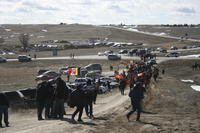The Pentagon announced Wednesday it is deploying 3,000 troops to areas of Europe following an order by President Joe Biden as fears of a Russian invasion of Ukraine escalate.
About 2,000 soldiers with the 82nd Airborne Division and 18th Airborne Corps will move in the coming days from Fort Bragg, North Carolina, to Germany and Poland, while the remaining 1,000 with an Army Stryker squadron already stationed in Germany will be redeployed to Romania, Pentagon spokesman John Kirby said.
"The current situation demands that we reinforce the deterrent and defensive posture on NATO's eastern flank," Kirby said.
Read Next: At Least 1 Million Vets Could Get VA Health Care Under Scaled-Back Exposures Bill
Both Poland and Romania are members of the NATO alliance and share a border with Ukraine, a western-leaning nation that is not an alliance member.
It is the first major movement of U.S. forces after the Biden administration warned that Russian President Vladimir Putin has amassed about 100,000 troops at Ukraine's borders who are prepared to invade at any moment.
The 82nd Airborne Division is deploying components of an Infantry Brigade Combat Team, and the 18th Airborne Corps is moving a joint task force headquarters to Germany. The Stryker unit will be joining 900 troops who were already in Romania as part of a U.S. rotational force.
None of the deployments are permanent, Kirby said.
Soldiers from Fort Bragg were among 8,500 troops who were put on heightened alert last week by Defense Secretary Lloyd Austin for a possible deployment as part of a NATO rapid response force of 40,000 troops from member nations.
"Those 8,500 are not currently being deployed, but remain ready to move if called for the NATO Response Force or as needed for other contingencies as directed by the secretary or by President Biden," Kirby said.
The bases that could still send troops to Europe are: Fort Bragg; Fort Campbell, Kentucky; Fort Carson, Colorado; Davis-Monthan Air Force Base, Arizona; Fort Hood, Texas; Joint Base Lewis-McChord, Washington; Fort Polk, Louisiana; Robins Air Force Base and Fort Stewart, Georgia; and Wright-Patterson Air Force Base, Ohio.
Both Biden and NATO Secretary General Jens Stoltenberg have made clear they do not intend to send troops into Ukraine. But the president and the Pentagon have said the U.S. is committed to the protection of NATO ally countries that border Ukraine, including Poland and Romania.
Putin has continued to move conventional ground, air and naval forces into position for a potential invasion, but has also staged forces that could conduct irregular operations such as cyber attacks, subversion and sabotage, said Seth Jones, director of the international security program at the Center for Strategic and International Studies.
"We would expect that if there was an invasion, we would absolutely see -- as we saw in Syria, for example, with the Russian deployment -- an initial focus on heavy offensive cyber operations against command-and-control structures [and] public critical infrastructure in Ukraine, as well as the airstrike from Russian fixed-wing aircraft and bombers against key locations," he said in a briefing to reporters Tuesday.
Jone said the Ukrainians have shown they can fight in a spectrum of warfare operations over the past few years and "in no way shape or form" would it be an easy fight for Russian invasion forces.
-- Travis Tritten can be reached at travis.tritten@military.com. Follow him on Twitter @Travis_Tritten.
Related: Troops at These Bases Are on Alert for Deployment over Ukraine Crisis












